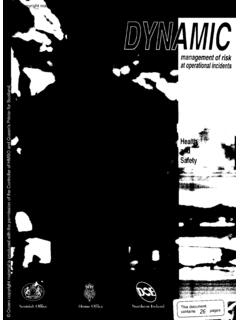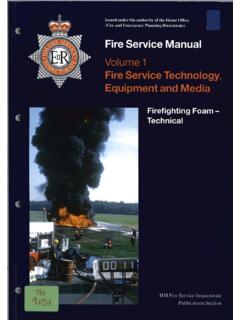Transcription of Fire Service Manual Volume 1 Fire Service Technology ...
1 Issued under the authority of the Home Office( fire and Emergency Planning Directorate) fire Service ManualVolume 1 fire Service Technology ,Equipment and MediaCommunicationsandMobilisingHM fire Service Inspectorate Publications SectionLondon: The Stationery Office Crown Copyright 1998 Published with the permission of the Home Officeon behalf of the Controller of Her Majesty's Stationery OfficeApplications for reproduction should be made inwriting to The Copyright Unit, Her Majesty's Stationery Office,St. Clements House, 2-16 Colegate, Norwich, NR3 1 BQISBNO 11 3411855 Cover photographs:Upper: Surrey fire and Rescue ServiceLower: London fire BrigadeHalf-title page photograph:Hertfordshire fire and Rescue ServicePrinted in the United Kingdom for The Stationery OfficeJ50973 7/98 C50 5673 Communicationsand MobilisingPrefaceThe first edition Part 5 of the Manual ofFiremanship dealing with the subject of communi-cations was issued in 1954.
2 It concluded "FireService communications are intimately related toan intricate field of electrical engineering, whichincludes telecommunications both by landline andwireless, which is in turn only a small part of theterritory covered by electrical science".The passage of time and advances in technologyhave changed every concept of fire Service com-munications from those identified by the writerswithin the first edition of Part 5. The basic fire ser-vices' communications requirements have, howev-er, remained unchanged and are identified in the1947 fire Services Act. This is still as relevanttoday as it was when first mandated to fire author-ities in 1947, to "secure efficient arrangements fordealing with calls for the assistance of the firebrigade in case of fire and for summoning mem-bers".
3 To ensure that fire services' communications effi-ciency is maintained to the highest level requiresthe introduction of modern Technology systems,coupled with frequent reviews to brigades' prac-tises and procedures. Changes in equipment andprocedures become inevitable, because eitherequipment becomes obsolete, or technical main-tenance support is exhausted or overly equipment often has advantages over what itreplaces, in that it generally incorporates morefunctionality and flexibility, thus affordinggreater opportunities for changes in proceduresand is an impossible task to bring the reader fully up-to-date with the Technology that is both availableand continually evolving, or indeed to indicate thatwhich may be available in the future.
4 This book iswritten in non-technical terms and aimed primari-ly at covering the operational and functional com-munications requirements of the professional fire -fighter. This, by necessity, encompasses all thecommunicating elements from that of "the origi-nating caller to the incident's conclusion" via thebrigade Control, station call-out and IncidentCommand structures. The text, diagrams and sym-bols used, whilst not necessarily conforming tothose in other technical publications, have beenmodified as appropriate to assist the reader. Thosewho require further technical detail must refer toother publications and technical sources whichspecialise in the area is anticipated that this book will be invaluable tobrigade Communications Officers and all person-nel who are or become intimately involved in theplanning, procurement, implementation and opera-tion of mobilising systems, communications sys-tems, radio and fixed and mobile in Book 10 of the Manual of Firemanship, agreat deal of emphasis has been placed upon plan-ning principles.
5 And the importance of clearly iden-tifying both the operational requirements and theconstraints associated with procurement Technology solutions can be both implement-ed and beneficial if, as a result of a due planningprocess, they address and meet the needs and cri-teria of 'the user'. New Technology should not,however, be seen as the driving force and the rea-son to change for changes sake. This is especiallyso in areas where an overall simpler solution couldbe adopted is hoped that the information and advice con-tained within this book will help to ensure that theFire Services' Communications and associatedCommunications and Mobilisingiiisystems will at least maintain and ideally improvetheir present standards of efficiency and Home Office is greatly indebted to all thosewho have contributed and assisted (by providingmaterial and information)
6 In the preparation of book replaces the Manual of FiremanshipBook 10 fire Brigade Communications OfficeJune 1998ivFire Service ManualCommunicationsand MobilisingContentsPreface HiChapter 1 Regulatory issues Government OFTEL Radio Frequency Management Home Office Communications Advisory Panel (HOCAP)
7 8 Chapter 2 fire Control Centres Basic Call Handling Procedures Control Centre Staffing Levels 15 Chapter 3 A brief history of the ' fire Control Centre' 17 Chapter 4 The 999/112 emergency Service BT The British Telecom fixed telephone system Operator call-handling procedures Mismatches between EA and Fixed Network Operator Boundaries Provision of ex-directory information Access to tape recordings of
8 Emergency Calls Calling Line Identity (CLI) Network Resilience Priority Fault Repair Service BT National Emergency Linkline Government Telephone Preference Scheme Secondary Control
9 Publicity/Public Education Cable & Wireless 999 Service Operator call-handling procedure Enquiries and requests from emergency services Kingston Communications Telephone Number Portability Emergency Text Telephone Service for the deaf Emergency calls from the Railway Industry Network Paypnones
10 Cellular communications Cellular 999 services Name and Address Information of Mobile Callers Release of Subscriber information System Description - ORANGE 37 Communications and Cell/EA

